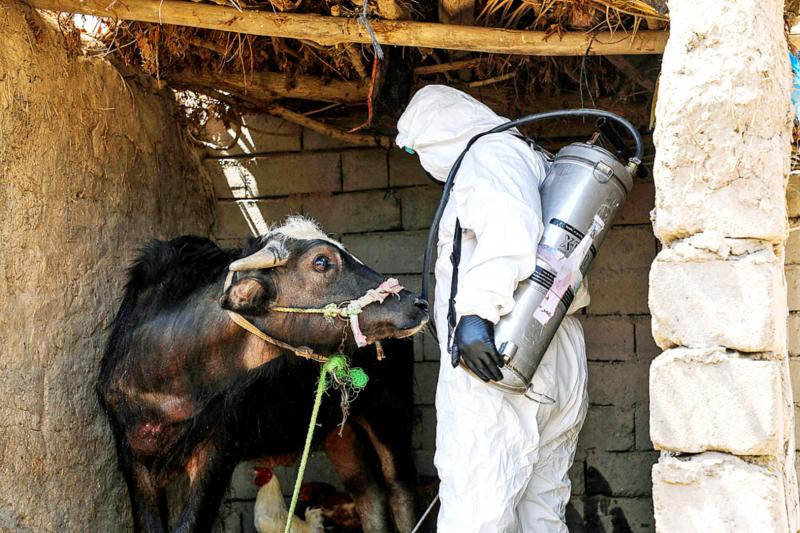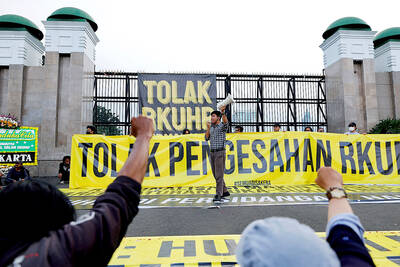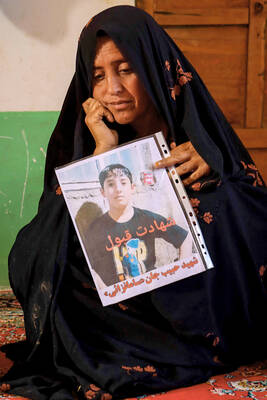Spraying a cow with pesticides, health workers target blood-sucking ticks at the heart of Iraq’s worst detected outbreak of a fever that causes people to bleed to death.
The sight of the health workers, dressed in full protective kit, is one that has become common in the Iraqi countryside, as the Crimean-Congo hemorrhagic fever (CCHF) spreads, jumping from animals to humans.
This year Iraq has recorded 19 deaths among 111 CCHF cases in humans, the WHO says.

Photo: AFP
The virus has no vaccine and onset can be swift, causing severe bleeding internally and externally, and especially from the nose.
It causes death in as many as two-fifths of cases, medics say.
“The number of cases recorded is unprecedented,” said Haidar Hantouche, a health official in Dhi Qar Governate.
A poor farming region in southern Iraq, the governate accounts for nearly half of Iraq’s cases.
In previous years, cases could be counted “on the fingers of one hand,” Hantouche said.
Transmitted by ticks, hosts of the virus include wild and farmed animals such as buffalo, cattle, goats and sheep, all of which are common in Dhi Qar.
In the village of Al-Bujari, a team disinfects animals in a stable next to a house where a woman was infected. Wearing masks, goggles and overalls, the workers spray a cow and her two calves with pesticides.
A worker displays ticks that have fallen from the cow and been gathered into a container.
“Animals become infected by the bite of infected ticks,” the WHO said. “The CCHF virus is transmitted to people either by tick bites or through contact with infected animal blood or tissues during and immediately after slaughter.”
The surge of cases this year has shocked officials, as numbers far exceed recorded cases in the 43 years since the virus was first documented in Iraq in 1979.
In Dhi Qar, only 16 cases resulting in seven deaths had been recorded last year, but this year it has recorded 43 cases, including eight deaths, Hantouche said.
The numbers are still tiny compared with the COVID-19 pandemic — where Iraq has registered more than 25,200 deaths and 2.3 million recorded cases, according to WHO figures — but health workers are worried.
Endemic in Africa, Asia, the Middle East and the Balkans, CCHF’s fatality rate is between 10 and 40 percent, the WHO says.
WHO representative in Iraq Ahmed Zouiten said there were several “hypotheses” for the country’s outbreak.
They include the spread of ticks in the absence of livestock spraying campaigns during COVID-19 in 2020 and last year, and “very cautiously, we attribute part of this outbreak to global warming, which has lengthened the period of multiplication of ticks,” he said.
However, “mortality seems to be declining,” as Iraq had mounted a spraying campaign while new hospital treatments had shown “good results,” he said.
As the virus is “primarily transmitted” to people via ticks on livestock, most cases are among farmers, slaughterhouse workers and veterinarians, the WHO says.
“Human-to-human transmission can occur resulting from close contact with the blood, secretions, organs or other bodily fluids of infected persons,” it says.
Alongside uncontrolled bleeding, the virus causes intense fever and vomiting.
Medics fear there might be an explosion of cases following the Muslim festival of Eid al-Adha in July, when families traditionally slaughter an animal to feed guests.
“With the increase in the slaughter of animals, and more contact with meat, there are fears of an increase in cases during Eid,” said Azhar al-Assadi, a doctor specializing in hematological diseases in a hospital in Nasiriya.
Authorities have put in place disinfection campaigns and are cracking down on abattoirs that do not follow hygiene protocols. Several provinces have also banned livestock movement across their borders.

Indonesia yesterday began enforcing its newly ratified penal code, replacing a Dutch-era criminal law that had governed the country for more than 80 years and marking a major shift in its legal landscape. Since proclaiming independence in 1945, the Southeast Asian country had continued to operate under a colonial framework widely criticized as outdated and misaligned with Indonesia’s social values. Efforts to revise the code stalled for decades as lawmakers debated how to balance human rights, religious norms and local traditions in the world’s most populous Muslim-majority nation. The 345-page Indonesian Penal Code, known as the KUHP, was passed in 2022. It

‘DISRESPECTFUL’: Katie Miller, the wife of Trump’s most influential adviser, drew ire by posting an image of Greenland in the colors of the US flag, captioning it ‘SOON’ US President Donald Trump on Sunday doubled down on his claim that Greenland should become part of the US, despite calls by the Danish prime minister to stop “threatening” the territory. Washington’s military intervention in Venezuela has reignited fears for Greenland, which Trump has repeatedly said he wants to annex, given its strategic location in the arctic. While aboard Air Force One en route to Washington, Trump reiterated the goal. “We need Greenland from the standpoint of national security, and Denmark is not going to be able to do it,” he said in response to a reporter’s question. “We’ll worry about Greenland in

PERILOUS JOURNEY: Over just a matter of days last month, about 1,600 Afghans who were at risk of perishing due to the cold weather were rescued in the mountains Habibullah set off from his home in western Afghanistan determined to find work in Iran, only for the 15-year-old to freeze to death while walking across the mountainous frontier. “He was forced to go, to bring food for the family,” his mother, Mah Jan, said at her mud home in Ghunjan village. “We have no food to eat, we have no clothes to wear. The house in which I live has no electricity, no water. I have no proper window, nothing to burn for heating,” she added, clutching a photograph of her son. Habibullah was one of at least 18 migrants who died

Russia early yesterday bombarded Ukraine, killing two people in the Kyiv region, authorities said on the eve of a diplomatic summit in France. A nationwide siren was issued just after midnight, while Ukraine’s military said air defenses were operating in several places. In the capital, a private medical facility caught fire as a result of the Russian strikes, killing one person and wounding three others, the State Emergency Service of Kyiv said. It released images of rescuers removing people on stretchers from a gutted building. Another pre-dawn attack on the neighboring city of Fastiv killed one man in his 70s, Kyiv Governor Mykola